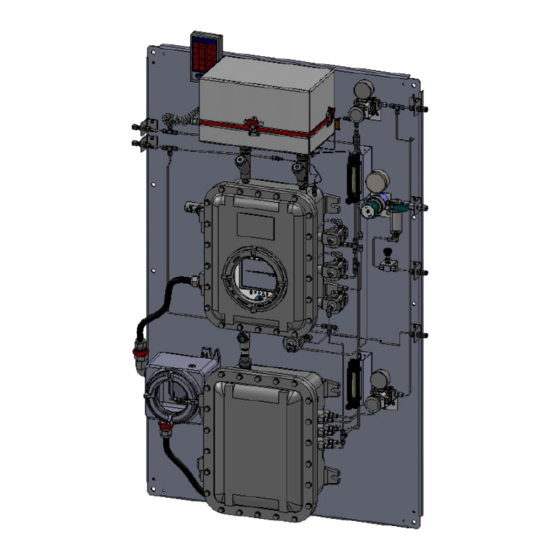Galvanic Applied Sciences AccuChrome Manual - Page 11
Browse online or download pdf Manual for Control Unit Galvanic Applied Sciences AccuChrome. Galvanic Applied Sciences AccuChrome 20 pages.

3.3 Gas Entry / Exit Connections
Gases are connected to the APIX device via a directly mounted manifold. Connections are by
1/16" inch tubing, welded into the manifold and pass through the wall of the explosionproof
enclosure through flame arrestor fittings. The APIX device requires six tubing connections to
the mounted gas manifold, inlet and vent pairs for each of actuation gas, carrier gas and
sample gas. All gas connections are prearranged on the unit backpanel and have shared unit
connections with the GC. The actuation gas is provided by the carrier gas line.
3.3.1
Supply Gas Pressure Requirements
The sample line is shared between the GC oven and the NEMS C9 Module. Two separate
flowmeters are used to control the flow of gas to the AccuChrome GC and to the APIX
module. Carrier gas and actuation gas are both shared with the rest of the AccuChrome unit.
Gas pressure and consumption specifications are provided in Table A1.
Table A1: NEMS C9 Module Gas Requirements
Min / Max
Gas Stream
Pressure [bar]
Carrier Input
1.0 / 2.0
Sample Input
0.3 / 1.5
Sample Vent
-
Actuation Input
3.5 / 4.5
3.4 Sample Injection
The sample injection mechanism consists of a silicon based micro injector which is integrated
into the NEMS module. The injection volume is typically on the order of 10 microliters and is
controlled via software.
3.5 Separation Column
The separation column is a 5-meter polydimethylsiloxane capillary column. It is housed
inside the NEMS module and is temperature controlled to ensure consistent retention times.
Typically, the C6 to C9 separation and characterisation can be achieved within 1 minute.
3.6 Detector
The detector is a NEMS resonator. It is very small and sensitive and has the unique
characteristic of becoming more sensitive for compounds that have higher molecular weight.
In natural gas the concentrations of the hydrocarbons decrease as the molecular weight
increases, which make the heaviest compounds the hardest to detect. With the NEMS
system the heaviest hydrocarbons have the strongest response.
Revision 1
Min / Max
Flow Rate
Design
[cm²/min]
Pressure [bar]
1.0
10 / 20
1.0
50 / 100
-
50 / 100
4.0
-
4
Design Flow
Rate
[cm²/min]
10
50
50
-
2021/10/01
